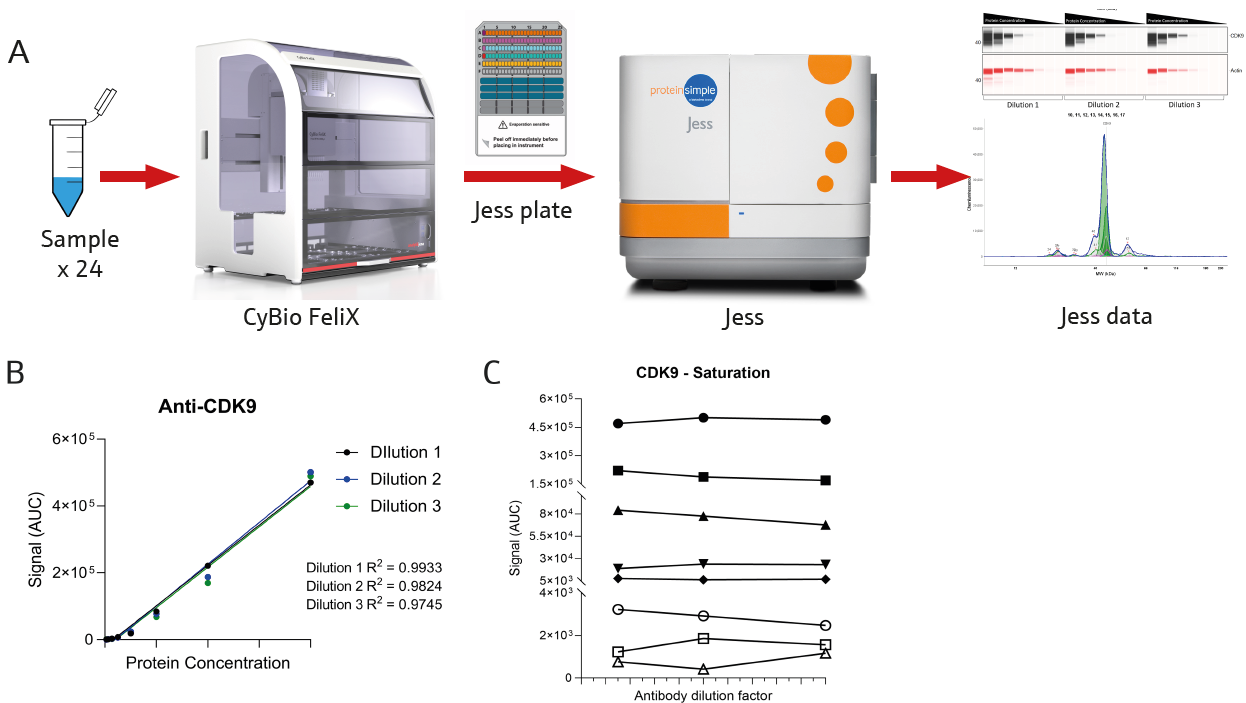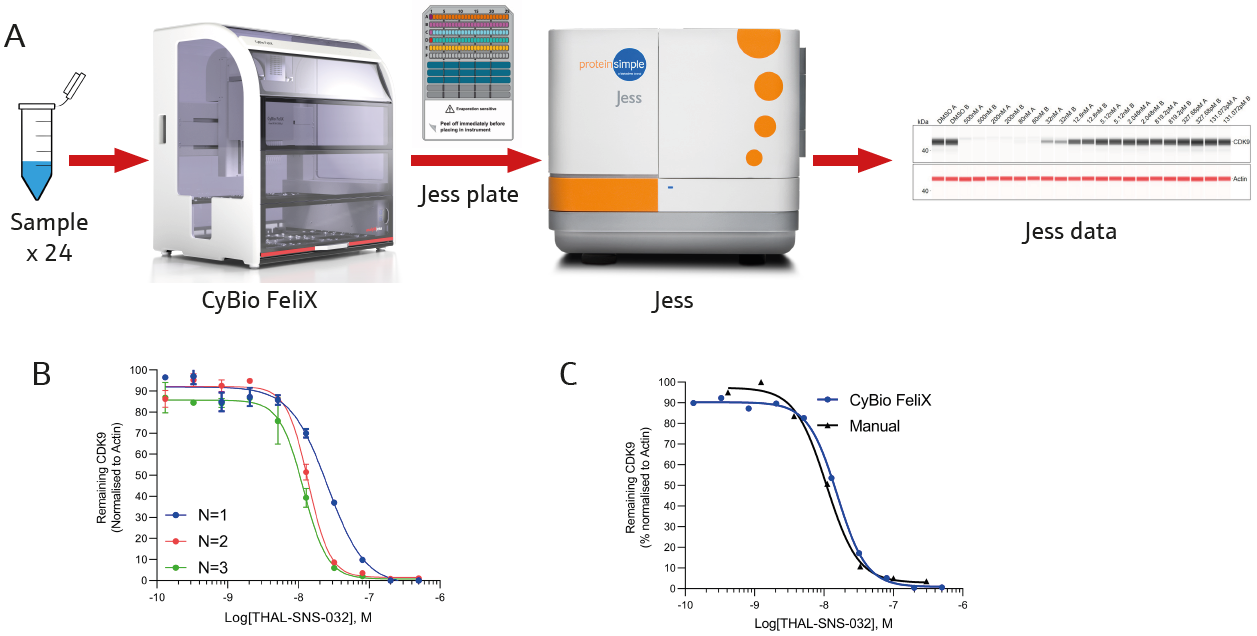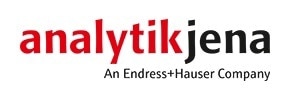This article is based on a poster originally authored by Melanie Kelm et. al.
ProteinSimple’s automated western blotting system, Jess, can be used in a range of applications, such as in drug discovery for applications like targeted protein degradation (TPD).
When paired with Analytik Jena’s CyBio FeliX Liquid Handler for protein quantification setup, normalization, and Jess plate preparation, workflow efficiency can be significantly enhanced.
PROTAC THAL-SNS-032 and its target molecule, CDK-9, were used to showcase the automation capabilities of the process. The quality of the automated process performed with the CyBio FeliX has proven to be just as good as that of the manual process, even saving the operator up to 60 minutes per Jess run.
Download the Poster
Introduction
Jess is a capillary-based automated Western blot instrument that has the capacity to screen 24 samples in approximately five hours. Automating the protein separation and immunodetection process removes any steps that may be prone to error, and the associated software is able to process the quantifiable data quickly.
At Charnwood Discovery, Jess is considered to be a standardized method in a repertoire of drug discovery techniques. The well-studied PROTAC THAL-SNS-032 was used to demonstrate the capabilities to further automate and simplify the Jess preparation procedure using the Analytik Jena CyBio FeliX liquid handling system.
1. Antibody optimization
Optimization of the anti-CDK9 antibody and loading control antibody (β-Actin) ensures saturation and signal linearity, thereby delivering quantifiable data. A serial dilution of the lysate was performed by introducing a stock cell lysate of predetermined protein concentration to the CyBio FeliX, which then prepared the Jess plate with varying antibody dilutions (Figure 1).
Jess data analysis establishes linear protein concentration-dependent detection of CDK9 and β-Actin (Figure 1B) while producing signals that signify saturation across antibody dilutions (Figure 1C).

Figure 1. (A) Schematic of antibody optimization. Samples with known target protein concentrations were used to determine and confirm linear signal response (B) as well as sufficient antibody saturation within the assay (C). Image Credit: Analytik Jena US
2. Sample generation & protein assay
Prior to collection, cells were seeded and treated with serially diluted SNS-THAL-032 and then washed with PBS before being lysed with RIPA buffer. Quantification rules are followed to ensure a concentration within the linear range of the antibody protein, which avoids camera saturation or ECL substrate depletion.
The BCA assay is then prepared using the CyBio FeliX, which applies a BSA standard curve for inferring the unknown sample concentrations by setting the absorbance at 562 nm (Figure 2).

Figure 2. Schematic of sampling and protein quantification. Total protein from cell lysate was quantified via BCA assay. The assay was prepared by the CyBio FeliX; the obtained
protein concentration information was used to normalize samples during PROTAC assay setup. Image Credit: Analytik Jena US
3. Protac assay: SNS-THAL-032 dose response
The optimization techniques carried out in section 1 facilitate the examination of the protein of interest in the test samples. The CyBio FeliX utilized the files created using the BCA assay in section 2 to prepare the Jess plates. Three biological replicates were then measured to establish the reproducibility of Jess plate preparation (Figure 3A).
Across multiple experiments, consistency of dose-dependent CDK9 degradation by SNS-THAL-032 (EC50 =16.1±7.6 nM) was confirmed (Figure 3B). The automated process that the CyBio FeliX runs matches the quality of manual processes (Figure 3C), saving around 60 minutes of bench time per Jess run.

Figure 3. (A) Schematic of the PROTAC assay. Samples with protein concentrations determined in section 2 were prepared for Jess analysis. CyBio FeliX uses protein quantification data to normalize sample protein concentrations. Triplicate analysis of SNS-THAL-032 mediated CDK9 degradation demonstrates the reproducibility of the automated setup (B); its quality is identical to manual processing (C). Image Credit: Analytik Jena US
Conclusion
The collaboration between Charnwood Discovery’s Simple Western expertise utilizing Jess and Analytik Jena’s liquid handling automation proficiency has resulted in the creation of a fully automated Western blotting method.
The CyBio FeliX sample processing significantly reduces bench time by approximately 60 minutes per Jess run, equating to potential savings of up to 45 hours of bench time per week.
Demonstrated through the degradation of CDK9 using PROTAC THAL-SNS-032, the CyBio FeliX showcases its capability to optimize antibody and sample protein concentrations, as well as prepare ProteinSimple Jess plates for screening purposes.
Download the Poster
About Analytik Jena US
Analytik Jena is a provider of instruments and products in the areas of analytical measuring technology and life science. Its portfolio includes the most modern analytical technology and complete systems for bioanalytical applications in the life science area.
Comprehensive laboratory software management and information systems (LIMS), service offerings, as well as device-specific consumables and disposables, such as reagents or plastic articles, complete the Group’s extensive range of products.
About life science
The Life Science product area demonstrates the biotechnological competence of Analytik Jena AG. We provide a wide product spectrum for automated total, as well as individual solutions for molecular diagnostics. Our products are focused to offer you a quality and the reproducibility of your laboratory results.
This will surely ease your daily work and speed up your work processes in a certain way. All together we support you through the complete process of the lab work. Besides we offer customized solutions and are able to adapt our products to your needs. Automated high-throughput screening systems for the pharmaceutical sector are also part of this segment’s extensive portfolio.
About analytical instrumentation
Analytik Jena has a long tradition in developing high-performance precision analytical systems which dates back to the inventions made by Ernst Abbe and Carl Zeiss. We have grown to become one of the most innovative manufacturers of analytical measuring technology worldwide.
Our business unit Analytical Instrumentation offers excellent competencies in the fields of optical spectroscopy, sum parameters and elemental analysis. Being proud of our core competency we grant all our customers a long-term warranty of 10 years for our high-performance optics.
About lab automation
With more than 25 years of market experience, Analytik Jena with its CyBio® Product Line is a leading provider for high quality liquid handling and automation technologies. In the pharmaceutical and life science industries, our products enjoy the highest reputation for precision, reliability, robustness and simplicity.
Moreover, the Automation Team designs, produces and installs fully automated systems tailored to our clients' application, throughput and capacity requirements. From stand-alone CyBio® Well up to fully customized robotic systems we handle your compounds, biomolecules and cells with great care.
Sponsored Content Policy: News-Medical.net publishes articles and related content that may be derived from sources where we have existing commercial relationships, provided such content adds value to the core editorial ethos of News-Medical.Net which is to educate and inform site visitors interested in medical research, science, medical devices and treatments.
Last Updated: Jul 8, 2024